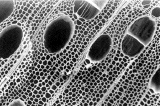

| 2 | History of Sumil / Characteristic of Sumi |
❮ Characteristic of Sumi1 Characteristic of Sumi3 >
■Differences between binchotan and bamboo charcoal
We need the proficient skills of an expert to make binchotan, and in addition to it, we need to wait a very long time until appropriate wood grows. Ubamegashi belongs to the beech family, and is suited for producing good quality binchotan. However good quality ubamegashi grows on the cliff of the inland area of southern Kishu peninsula, the amount of it is decreasing after mass logging. We must wait no fewer than 30 years until ubamegashi grows big enough to use for Sumi once it has been cut down. So we value the binchotan made of ubamegashi from southern Kishu peninsula very much. A Sumi charcoal creator goes into the mountain on a pathless passage hearing the sound of nature, finds the ubamegashi trees on steep ground, carefully chooses some of them and then finally cuts them only as needed. The creator burns them to make charcoal at over 1,000 degrees Celsius. The making of binchotan requires that every single process is done by hand, from cutting the trees to taking the Sumi out from the kiln. So we can say that binchotan is full of the creatorユs life and soul.
On the other hand, bamboo charcoal is mainly used as active charcoal-wise or in household products for purifications, soil improvements, rice cooking and to improve bathwater. Since cutting out bamboo means a lot to encourage bamboo grove improvement, it is very easy to obtain massive amounts of bamboo and make much bamboo charcoal.
■Did you know? The effects of charcoal in modern technology
Charcoal, which looks like a black lump, is a knot of fine structures in the form of a pipe. Thousands of micro pores are formed on the surface of the Sumi charcoal, especially in the binchotan, by joining the pipes together extensively.
The surface area of the hole is about 300 square meters per 1 gram which if laid out would make more than one tennis court. By the fluid or moisture passing through the pores,hazardous substances, impurities and smell molecules are adsorbed inside of the pore and the effects to remove the smell and moisture start functioning.
Furthermore, the charcoal works as a bioreactor, since microbes are living in these pores and clean the absorbed hazardous substances and release it into the air after their detoxifying action.
 Magnified cross section
view of Sumi charcoal
Magnified cross section
view of Sumi charcoal
The floor boards of the old wooden architecture such as Horyuji temple
or Ise Jingu shrine is covered with charcoal. We can tell how much our
ancestors knew about the characteristics of charcoal and made use of it
in their lives.
We do not see charcoal very much these days, but the charcoal is used to support us in various ways and methods through modern technology.
The charcoal is used to serve the healthcare and the environmental issues in recent years on top of its usage as an energy or a carbon material.
Charcoal has various ways of usage depending on its material or shape. You
may have heard of the word ''carbon nanotube,'
for example. This is a cylindrical substance made of carbon with approximately
0.8 to 10 nanometers, 1 nanometer is equal to 1 thousandth to 100 thousandth
of a human hair in diameter which has 100 times of hardness and weigh
a 6th of iron. Complex materials made by the carbon
nanotubes with harness of the nature of carbon, and has
been applied in various fields due to its qualities such as lightweight,
high-strength, high elasticity and heat-resisting.
As charcoal is intermediately structured between diamond and lead and
it is not crystalline, it is utilized widely as black pigment, or fine
particles of carbon. Also a carbon material, called carbon nanohorn, which
research is proceeding at this moment, is a kind of carbon nanotube with
sharpened edge and that is nano carbon which will soon be put into practical
use as an electrode material in power fuel cells or a gas storage material
that might help in new energy resources.
Carbon pigment consists of carbon materials of 300 to 500 nanometers in
diameter that features radiating the heat. Used in the plastic sheets
in the tires and the electric carpets.
Today, you see foliage plants at the shop, in the office and so many different places. Even there, you can see the effect of the power of the charcoal. You may not know the word 'hydroculture,' but may have seen it. It is when you grow a plant with clay pellets instead of soil and the charcoal is used as a material in the clay pellets. It cleans the air by purifying harmful materials, is rich in minerals and requires little maintenance. Therefore, people use it for rooftop gardening and it results as a contribution to global environment improvement.
❮ Characteristic of Sumi1 Characteristic ofSumi3 >
Back to the top on this pageHistory of Sumi / Characteristic of Sumi